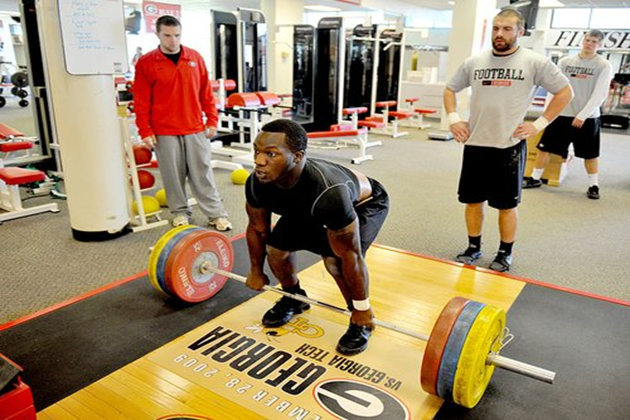| The 6 Worst Mistakes Football Players Make in the
Provided By: Stack.com
 Size, strength, speed and power are absolutely essential for the game of football. So, football players need to focus their off-season training on improving these athletic attributes. Most football players have good intentions going into their summer off-season training, but sometimes they fail to achieve their goals. One poor decision or training mistake can completely derail your program and undermine all your hard work in the weight room. To make the most out of your off-season football training, formulate a plan and avoid these six common mistakes. 1. Neglecting Your Neck Football is a game of contact. Any time there is a collision or tackle, your head experiences some type of force due to the rapid deceleration and change of direction that occurs when you're stopped in your tracks. If the force is too great, you might sustain a concussion. The neck serves as a vital connection between your body and head. Strengthening your nearly two-dozen neck muscles will protect your cervical spine and help reduce the amount of force transferred to your head during contact. (Learn more about the importance of neck strength.) Solution: Begin training your neck by performing full-range-of-motion exercises and incorporating manually resisted isometrics. The isometrics are performed for time, which should gradually increase as your muscular strength improves. Speed: The time limit for the 30-yard sprints is based upon your best overall 30-yard sprint time (recorded in a separate session). Each player should complete her 30-yards in no less time than her best 30 time plus 10 percent. For example, if a player runs her best 30-yard sprint in 4 seconds, she must complete each sprint in less than 4.4 seconds. Muscles Targeted: Scalenes and Levator Scapulae Assume an all-fours position on the floor with a physioball between the side of your head and a wall. Drive your head into the ball, keeping your chin tucked and eyes fixed on the floor. Hold for 10 to 20 seconds. Perform a set on opposite side. Cervical Neck Flexion Iso Muscles Targeted: Suprahyoid, Infrahyoid and Sternocleidomastoid Assume a kneeling position on the floor with a physioball between your forehead and a wall. Drive your forehead into the ball, attempting to tuck your chin to your chest. Hold for 10-20 seconds. Neck Extension Iso Muscles Targeted: Splenius, Longissimus and Semispinalis Stand facing away from a wall and with a physioball between the back of your head and the wall. Drive the crown of your head into the ball, attempting to look up through your brow line. Hold for 10-20 seconds. 2. Ignoring Aerobic Exercise Many players and coaches are under the impression that football is a purely anaerobic sprint sport. However, a football game—especially in high school, where players often play multiple positions—does require endurance; and the energy system typically associated with long-distance running helps you recover between plays and sustain your performance for the length of a game. Solution: Incorporate tempo runs into your program twice per week. Start with two to three sets of 400-meter tempo runs (maintain 80 to 85% max speed), resting for the same amount of time it took you to complete the run before you start the next set. Do these at the end of your workout so that you are not fatigued when performing your strength and speed work. 3. Being Preoccupied with One-Rep Maxes As a strength and conditioning coach, powerlifter and former athlete, I understand the desire to set new one-rep max records. However, a huge max doesn't always equate to enhanced performance on the field. Your max strength is important to an extent, but you also need to focus on power, endurance, conditioning and durability. Solution: There's no need to perform one-rep maxes on a regular basis. Instead, measure your one-rep max at the start of your off-season program and follow a training plan that is based on your max numbers. Retest your max at the conclusion of a training cycle to measure your progress. 4. Gaining Weight via Junk Food In a mad dash to gain weight, many players resort to eating everything in sight. They regularly crush fast food, soda, ice cream and pizza, hoping that the calorie surge will help them hit their weight goal. If you take this approach, you will certainly gain weight. But it will be undesirable fat that will only slow you down. Consuming calories from substandard sources will also impede recovery, limit training gains, elevate your blood sugar and impair digestion. If you are heavier and dependent on junk food, you will feel bloated and tired once tryouts hit, masking your true athletic ability. Solution: Gaining weight is all about energy surplus. Eating more calories than you burn creates the right environment for muscle growth. However, the calories need to come from quality sources, such as lean protein, whole grains, healthy fats, fruits and vegetables. Cut out sodas and other sugary drinks from your diet, and stick to water, tea and natural fruit juice. No exceptions! 5. Using Poor Olympic Lifting Technique A high school football player looking to play at the collegiate level must be able to perform the Power Clean and Snatch. These movements will literally improve every aspect of your game, and they are staples of collegiate training programs. But they are complicated lifts and they take practice to learn. Unfortunately, high school athletes often skip this step. They tend to jump right into the movement, and end up performing something that looks more like a wonky Reverse Curl. Solution: Learn how to perform the Clean and Snatch by mastering the several movements that make up the lift in a careful progression. Perfect each of the following movements in this exact order to ensure that you learn the proper movement patterns.
6. Failing to Get Sufficient Sleep Many young athletes are unknowingly sleep-deprived. Staying up late playing video games or talking with friends can take a serious toll on your performance. In fact, failing to get enough sleep can actually impair muscle growth and recovery. Solution: Strive to get at least eight or nine hours of sleep each night. Avoid caffeinated beverages after noon each day, and don't eat sugary foods before bed. Turn off all sources of artificial light to help you fall into a deeper sleep.
|






